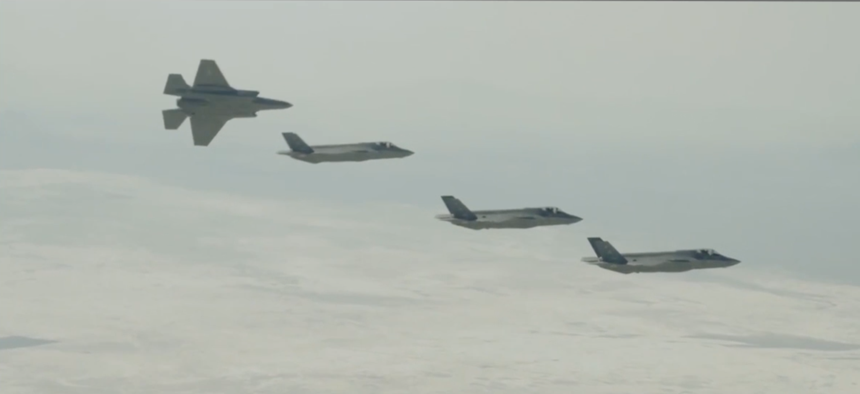
Screengrab via Lockheed Martin
A Glimpse At How the F-35 Will Help the Marines Storm the Beach
In a California demonstration, the short-takeoff fighters escorted troop-carrying V-22s into simulated hostile territory.
Earlier this month, six F-35B Joint Strike Fighters took off from the deck of USS America, a Navy amphibious assault ship off San Diego, California. Four of the Marine Corps aircraft attacked a simulated integrated air defense system on San Clemente Island, while the other two escorted a pair of Boeing V-22 Ospreys that simulated landing Marines on an enemy beach. The Nov. 20 demonstration was a unique “proof of concept” strike/assault support escort mission that also included a Bell UH-1Y Venom helicopter, a Bell AH-1Z Viper, and a Sikorsky MH-60S helicopter . This was a test of the so-called “Lightning Carrier” concept , an aircraft carrier loaded with F-35s and Ospreys. The goal: to show how the Marines would use the F-35B during the first, critical stages of expeditionary fighting, perhaps at the start of a major conflict.
Lt. Gen. Jon Davis, the Corps’ top aviation leader, said the F-35B rolls the capabilities of several older aircraft into one: situational awareness, electronic warfare, close air support, air-to-air combat. That makes the V-22 Osprey better at putting boots onto contested ground.
“If I was a bad guy, I would hate the V-22,” said Davis, the Marines’ deputy commandant for aviation. “And if you hate the V-22 out there and you want to try and go after the V-22, the F-35 will create the conditions for success for the V-22 in sanitizing a target area, going after target defenses, [providing] close air support.”
Eventually, the Marines want to integrate the F35B with today’s Sikorsky CH-53E Super Stallion and the coming Sikorsky CH-53K King Stallions , the latter of which is slated to enter service in 2018.
The F-35B has reached a threshold in its long and tortuous journey to its first deployment, to the Marine Corps Air Station in Iwakuni, Japan, in January. After the Marines declared initial operating capability in 2015, the Defense Department’s Operational Test and Evaluation Office retorted that the operational test “did not — and could not — demonstrate that the Block 28 F-35B is operationally effective or suitable for use in any type of limited combat operation, or that it is ready for real-world operational deployments, given the way the event was structured.”
There were serious questions about whether the plane’s weapons would function as planned (they’ve since tested weapons releases ), and whether the complex Autonomic Logistics Information System , or ALIS, would work.
The Marines said that they had ALIS (version 2.0) aboard the America during their exercises this November and that it was indeed working, albeit with some help from plane builder Lockheed Martin.
See also Canada Ditches the F-35 for the Super Hornet — For Now
Would Davis be willing to send the F-35B into combat by the 2018, which the jet is scheduled to be deployed . “I would do it tomorrow,” he said.
“We will deploy on timeline with these other capabilities unless something requires us to go sooner faster. But they’re ready. They’re ready. The nation has its 5th-generation capability that can operate from a sea base and do it tomorrow,” Davis said.
